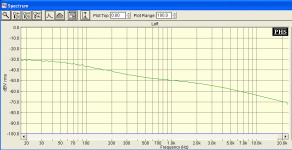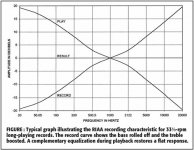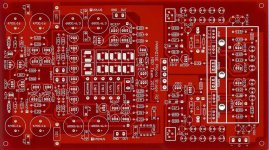What do you use to measure such tight tollerances? Or do you just match the chanels?
I used a LCR meter, some older device from HP whose number escapes me right now. I bought it at the ETF 2011, an it works just beautifully. I measured the capacitors that went in there, and combined them with additional small caps to achieve the exact value from the schematic. Yes, I rely on this LCR meter to claim the 0.1%, which is only true if that meter is that precise. But the two channels do match to each other that well. (And I calibrated my meter with another meter that just went through calibration....)
RIAA precision is a different thing. The caps and resistors need to be precise (what I tried to achieve), but as Joachim pointed out the other impedances in the circuit do play a role as well. The Paradise circuit tries to minimize these as much as possible, and as we have seen from Stefanoo's simulations the results are very close. What we are still missing is an actual measurement, using a anti-RIAA circuit, to find out if that is true.
But that raises the question, how precise can that be, when your components are 0.1% or so? This can be calculated (don'T forget the precision of the signal generator), only I haven't done it.... I think Joachim made that estimation in his FPS article....
Its the outcome that counts. So most practical is to measure curves since this circuit responds to impedance division against the filtering components. Without an inverse Riaa feed-through for flat, we can always take the filtered curve and then compare it against the textbook Riaa curve. Here is one FFT of a tube phono that way. And there is no anti-Riaa circuit tolerance creeping in.
Attachments
I have measured the new Pardise with an Anti RIIA and have posted the results. With the value that MiiB has chosen we get 0.75dB plus at 20Hz and 0.25dB plus at 20kHz. In a broad range between 300Hz and 10kHz the response is flat so we have a very slight loudness character. With Stefanos and Ricardos values the response will be flatter.
For me that is good enough provided that the channels match.
By 0.2dB ? (0.172)
With a scope that has two channels and a mathematics function it is quite easy to check if the channels are similar-
Scope usually has a vertical accuracy of 5%.
What I have is a precision 5 1/2 digit Fluke meter and created a reference file with the RIAA using top level HP Meter I had access to for a couple of months.
Then I play the file and measure the output with my Fluke and record the variation and plot it vs. Frequency.
That as proven to be accurate to 0.05dB.
When I get the board I will be able to make reference measurements for all the community here and I will share the results with all of you.
What I have is a precision 5 1/2 digit Fluke meter
A 5 1/2 digit LCR meter doesn't automatically have a 0.05% accuracy.
Basic accuracy of 0.05% doesn't automatically mean the measurement will be 0.05% accurate.
Capacitors have three parameters, i'd advise you to read an introduction to precise LCR meters, e.g. from Agilent, Wayne Kerr.
(me have a Philips 6340C with 0.05% basic accuracy, took me a course to manage to measure to that level)
I meant the reference file I have created has an accuracy under 0.05%.
I created with the topo of the line Agilent meter.
I play the file at a level that will set a good spot for the meter thus allowing it to go down to 0.1% or better.
I got the idea of creating the reference file after going through a lot of pain in trying to measure the RIAA for another project I was developing and I was using an excel spreadsheet with a lot of formula to calculate the accuracy.
The process was really elaborate and I had to come out with a better and faster way but yet precise and that is when I got this idea.
Obviously playing the file also works if you have a flat soundcard to play with and my EMU 0204 is very good for this purpose and that is why I specifically choose this model sa it has a very flat frequency response.
I would recommend this method, it will be very straightforward to plot the frequency response.
Edit: I will definitely read the material you outlined
I created with the topo of the line Agilent meter.
I play the file at a level that will set a good spot for the meter thus allowing it to go down to 0.1% or better.
I got the idea of creating the reference file after going through a lot of pain in trying to measure the RIAA for another project I was developing and I was using an excel spreadsheet with a lot of formula to calculate the accuracy.
The process was really elaborate and I had to come out with a better and faster way but yet precise and that is when I got this idea.
Obviously playing the file also works if you have a flat soundcard to play with and my EMU 0204 is very good for this purpose and that is why I specifically choose this model sa it has a very flat frequency response.
I would recommend this method, it will be very straightforward to plot the frequency response.
Edit: I will definitely read the material you outlined
What is the point of a truly linear riaa.... Ok I know the answer to that, but the fact is that records are not cut that precise. This lift makes most records listenable, not only those cut on the warm side of the curve. I'd rather be able to listen to all my records with good result, than have to ditch half, due to an absoluteness to accuracy. To me a Riaa is for decoding the music, not decoding the record...(does it make sense...??
Off course people may alter values as they please, but for most I'd recommend that the slight base lift is kept.
Salas...The impedance of the mirrors here is primarily set by the impedance of the current source driving them, there are two things to say about the mirrors, one is impedance, the other is current gain. The latter determines the offset, the first has influence on the RIAA network. The impedance ha also great influence on the distortion spectra of the RIAA. The current gain balance is set by the two resistors. the better matched they are, the smaller the offset and the less the servo has to work.
Off course people may alter values as they please, but for most I'd recommend that the slight base lift is kept.
Salas...The impedance of the mirrors here is primarily set by the impedance of the current source driving them, there are two things to say about the mirrors, one is impedance, the other is current gain. The latter determines the offset, the first has influence on the RIAA network. The impedance ha also great influence on the distortion spectra of the RIAA. The current gain balance is set by the two resistors. the better matched they are, the smaller the offset and the less the servo has to work.
Last edited:
What is the point of a truly linear riaa.... Ok I know the answer to that, but the fact is that records are not cut that precise. This lift makes most records listenable, not only those cut on the warm side of the curve. I'd rather be able to listen to all my records with good result, than have to ditch half, due to an absoluteness to accuracy. To me a Riaa is for decoding the music, not decoding the record...(does it make sense...??
Off course people may alter values as they please, but for most I'd recommend that the slight base lift is kept.
Salas...The impedance of the mirrors here is primarily set by the impedance of the current source driving them, there are two things to say about the mirrors, one is impedance, the other is current gain. The latter determines the offset, the first has influence on the RIAA network. The impedance ha also great influence on the distortion spectra of the RIAA. The current gain balance is set by the two resistors. the better matched they are, the smaller the offset and the less the servo has to work.
And that is why 99% of my vinyl collection is pure audiophile pressing.
If you are striving for the top quality on the design you can't then put on vinyls pressed and mastered using low quality/old equipment.
Now if just want to listen specific music that you can't find in audiopile grade, then I find my self I am better off listening to it in digital format.
This is just my opinion...
Salas...The impedance of the mirrors here is primarily set by the impedance of the current source driving them, there are two things to say about the mirrors, one is impedance, the other is current gain. The latter determines the offset, the first has influence on the RIAA network. The impedance ha also great influence on the distortion spectra of the RIAA. The current gain balance is set by the two resistors. the better matched they are, the smaller the offset and the less the servo has to work.
Talking the 120R ones? Face to face bonding of mirror BJTs non critical?
What is the point of a truly linear riaa.... Ok I know the answer to that, but the fact is that records are not cut that precise. This lift makes most records listenable, not only those cut on the warm side of the curve. I'd rather be able to listen to all my records with good result, than have to ditch half, due to an absoluteness to accuracy. To me a Riaa is for decoding the music, not decoding the record...(does it make sense...??
QUOTE]
And then consider all the works that happens in the recording studio and all those fancy knobs on the desk and so on and once on tape same more knobs get twisted around just to get the right number of tracks with the right lenght in the limited space a LP offers.
And then the Neuman resistor that never realy had a value to start with
But if one got a precise start point then things wont be much different between extremes.
IMO capacitors at 1% are fine by me I am more concerned with the flavor they may ad (coloration to harsh word for Paradise)
So if teflon is the way count me in for GB but also stiroflex from LCR are prety good, they do brighten up the sound in my personal experiece but then this may be just what my old and worn ears need.
And then I would realy like to try same Z foils for the RIAA as signal go troug those before it ge dumped to ground by the caps
In the mean time sorry if not here to often it is difficoult to leave the Spinner alone latley
Last edited:
What is the point of a truly linear riaa.... Ok I know the answer to that, but the fact is that records are not cut that precise. This lift makes most records listenable, not only those cut on the warm side of the curve. I'd rather be able to listen to all my records with good result, than have to ditch half, due to an absoluteness to accuracy. To me a Riaa is for decoding the music, not decoding the record...(does it make sense...??
QUOTE]
And then consider all the works that happens in the recording studio and all those fancy knobs on the desk and so on and once on tape same more knobs get twisted around just to get the right number of tracks with the right lenght in the limited space a LP offers.
And then the Neuman resistor that never realy had a value to start with
But if one got a precise start point then things wont be much different between extremes.
IMO capacitors at 1% are fine by me I am more concerned with the flavor they may ad (coloration to harsh word for Paradise)
So if teflon is the way count me in for GB but also stiroflex from LCR are prety good, they do brighten up the sound in my personal experiece but then this may be just what my old and worn ears need.
In the mean time sorry if not here to often it is difficoult to leave the Spinner alone latley
I fully agree with you. There are already a lot of compensation durind the process.
So I would stick as much as possible to the standard curve without worrying too much.
also, like you said the most important thing is the sound signature introduced by the capacitors and the Teflon V-CAP CuTFT is the best capacitor I have ever tried period.
If we get to the point to do a group by for these caps and have them on the phono, you will see how good they can sound...they will re-define the standard for capacitors.
Salas...The impedance of the mirrors here is primarily set by the impedance of the current source driving them, there are two things to say about the mirrors, one is impedance, the other is current gain. The latter determines the offset, the first has influence on the RIAA network. The impedance ha also great influence on the distortion spectra of the RIAA. The current gain balance is set by the two resistors. the better matched they are, the smaller the offset and the less the servo has to work.
Hi Miib
What resistors are you refering to ?
@ all the wise guys,What is the point of a truly linear riaa.... Ok I know the answer to that, but the fact is that records are not cut that precise. This lift makes most records listenable, not only those cut on the warm side of the curve. I'd rather be able to listen to all my records with good result, than have to ditch half, due to an absoluteness to accuracy. To me a Riaa is for decoding the music, not decoding the record...(does it make sense...??
Off course people may alter values as they please, but for most I'd recommend that the slight base lift is kept.
Salas...The impedance of the mirrors here is primarily set by the impedance of the current source driving them, there are two things to say about the mirrors, one is impedance, the other is current gain. The latter determines the offset, the first has influence on the RIAA network. The impedance ha also great influence on the distortion spectra of the RIAA. The current gain balance is set by the two resistors. the better matched they are, the smaller the offset and the less the servo has to work.
will there be, one day, a guide to all these, for the innocent fool,
as me ?
In this thread is so much knowledge assembled, it would take another lifetime for me to get rid with it.
Please, if i'm not asking for to much, please, somebody should help us (yes i do think i'm not alone) translate a bit for the dumb.
Let me say, in my opinion, this is by far the best thread i had the joy to follow !
And that is why 99% of my vinyl collection is pure audiophile pressing.
If you are striving for the top quality on the design you can't then put on vinyls pressed and mastered using low quality/old equipment.
Now if just want to listen specific music that you can't find in audiopile grade, then I find my self I am better off listening to it in digital format.
Poor you....Do you have any idea about the treasures you missing out on...??
by far the best thread i had the joy to follow
Mr Gerhard still is a breath of fresh air (and he does phono)


